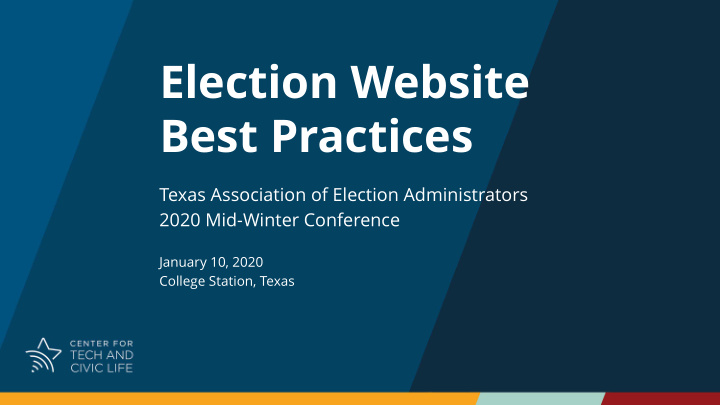



Election Website Best Practices Texas Association of Election Administrators 2020 Mid-Winter Conference January 10, 2020 College Station, Texas
Session objectives • Better understand voters’ informational needs • Be familiar with principles of plain design and plain language • Know immediate actions you can take to improve your election website • Have resources to help you improve your site
Nice to meet you!
Center for Tech and Civic Life We connect Americans with the information they need to become and remain civically engaged, and ensure that our elections are more professional, inclusive, and secure. @HelloCTCL www.techandciviclife.org
Civic Data We provide affordable, open-source civic data so that voters can have a more informed and engaged relationship with their government.
Government Services We support election officials with industry best practices, free tech solutions, and cutting-edge training to make elections more trustworthy and inclusive.
Best practices from the field www.techandciviclife.org/news-and-events
Free tools www.electiontools.org
Professional development courses www.techandciviclife.org/courses
How can you address your community’s needs? PROVIDING KEY ELECTION INFORMATION
Top questions for voters 1. What is on the ballot? 2. How do I get an absentee ballot, and when is it due? 3. Where do I vote? 4. Who is in office now? 5. How do I register to vote? Top question for non-voters 1. How do I participate in an election?
Let’s experiment What’s it like to search for information on a county election website?
#1 What is on the ballot?
#2 How do I get an absentee ballot, and when is it due?
#3 How do I register to vote?
Recap • Was it easy to find what you needed? • Did the sites remind you of your own website? • What suggestions do you have to improve the sites?
How design and language are related to usability MAKING ELECTION INFORMATION USABLE
Design à usability
What is plain design? When you publish content using plain design, readers can quickly and easily find the information they need.
Plain design guidelines • Include white space to make content manageable • Use menus and headings effectively • Use lists where appropriate • Align content to the left of the page • Use a sans serif font that is at least 12 point size • Use strong contrast between text color and background color
What is plain language? Plain language is writing designed to ensure the reader understands as quickly, easily, and completely as possible. Source: https://en.wikipedia.org/wiki/Plain_language
If you are unable to locate your voter registration information but think you are registered to vote and you Before: have not moved outside of your county of prior registration, you may be eligible to cast a provisional ballot during in person absentee voting period at an appropriate early voting location or the county board of elections, or on Election Day at the correct polling place for your current address that may be counted. After: If election workers can’t verify your voter registration, you can vote using a provisional ballot. Learn more about provisional ballots on our website.
Why is plain language important? • Reaches people with low literacy • Increases accessibility • Avoids misunderstandings • Creates transparency • Builds trust between you and the public
Plain language guidelines • Write in the positive • Use active rather than passive voice • Address the reader directly • Use short words, short sentences, and short sections • Use the words voters will be looking for, and avoid jargon
Where do you go from here? STEPS TO IMPROVE YOUR WEBSITE
Simplify
Let your menu do the work
Cut redundant content
Use clear terminology
Answer voters’ top questions
Test mobile friendliness https://search.google.com/test/mobile-friendly
Looking for additional support to improve your election website? ELECTION WEBSITE RESOURCES
Center for Civic Design field guide www.civicdesign.org/fieldguides/
Course: Building a New Election Website www.techandciviclife.org/courses
Course: Improving Your Election Website www.techandciviclife.org/courses
Build your own site using our template www.electiontools.org/tool/election-website-template
Usability Testing Kit www.electiontools.org/tool/usability-testing-kit
Reviewing our objectives • Better understand voters’ informational needs • Be familiar with principles of plain design and plain language • Know immediate actions you can take to improve your election website • Have resources to help you improve your site
Vote at Home training for election officials Free, 60-minute webinars covering best practices in local Vote at Home administration Envelope design Thursday, February 13th | 2pm EST Supplementary materials Tuesday, February 18th | 2pm EST Tools for tracking Tuesday, February 20th | 2pm EST www.techandciviclife.org/vote-at-home
Self-paced election cybersecurity courses ctcl.pathwright.com
Questions? Website: www.techandciviclife.org Email: hello@techandciviclife.org Twitter: @HelloCTCL
Recommend
More recommend